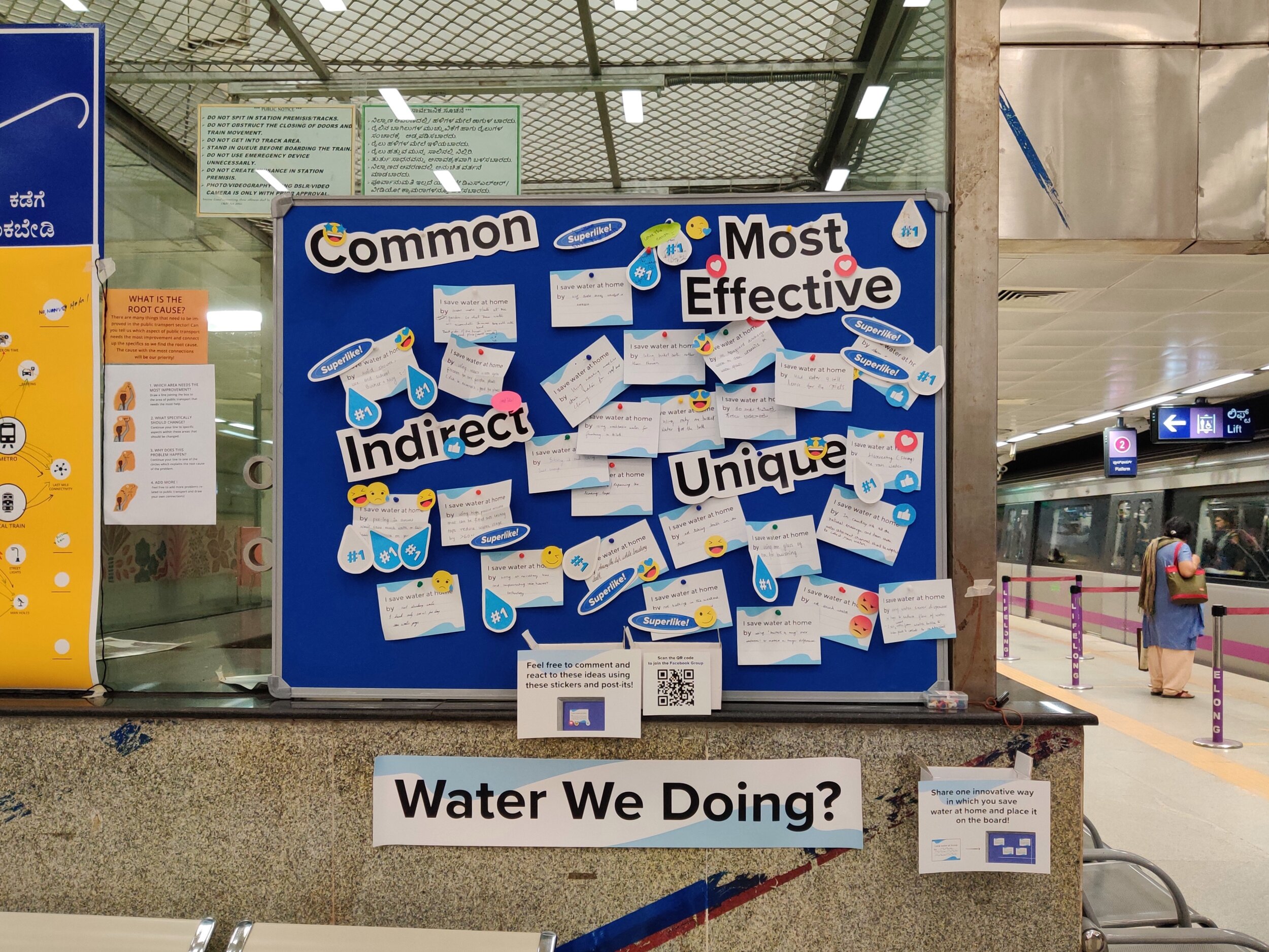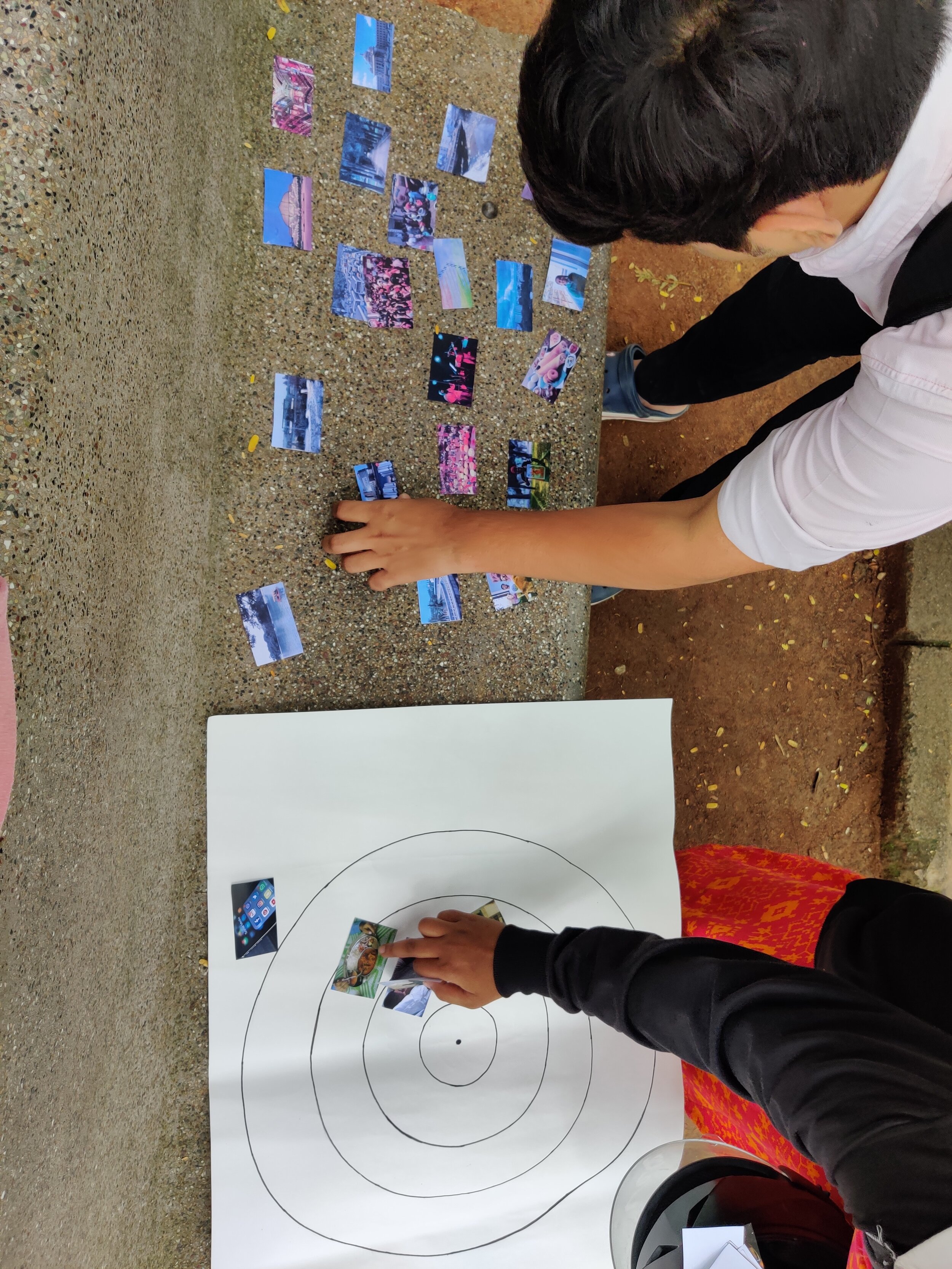
Water you doing?
Encouraging Conversations around Saving Water
‘Water you doing?’ is a platform that aims to engage people at the metro station in conversations around saving water. Bangalore’s population is increasing so rapidly that it is predicted to hit 20 million by 2031 and at present the BWSSB can only provide water to 60 percent of the population. People are scared that their water supply could be cut off at any point of time leading to a ‘Water Mafia’. Water management is a direct choice made by the people and is an important resource for all of humankind.
December 2019
Space and Behaviour
Apart from secondary research that gave me insights about the water crisis in Karnataka and the way games help us engage with real world problems, I wanted to indulge deeper into the behaviour of people around the space and their idea about sustainability.
First Impressions
• Everyone is in a rush to reach their destination
• Not much regards for strangers, very isolated behaviour
• People are indifferent the existing exhibits of Art in Transit
• Almost everyone is into their phones
• Rush hours are very cramped up and don’t allow any space for interactions
• The crowd consists of people mostly from the working class and those who have come to visit Cubbon Park
• Unkempt surroundings right outside the metro station
• Lots of space that could be used at prospective interaction points
• Entering and exiting the station; government spaces around
• More comfortable as compared to other forms of public transportation
• Weekend vs. weekday crowd is different
• Cases of harassment and theft
• People who use the metro vs. the staff at the station
• Maximum engagement possibilities are at the platform level, while more time-consuming processes are suitable for the corridors.
Social Experiment
As an experiment, I had placed empty chocolate wrappers around the metro station as shown above – on the floor right around the metro station as shown above – on the floor right below the stairs, on the chairs, near the entrance. My aim was to understand if people see a wrapper in an otherwise very clean space, will they want to pick it up and throw it in the trash bin or not. In the duration of 4 hours, not a single person picked up the wrapper. People sat on it, stepped on it and even acknowledged it, but not a single person picked it up.
Are people so used to seeing the planet treated this way that they feel it is ‘normal’?
Exploratory Games
For understanding the thought process of the crowd at Cubbon Park metro station, I conducted 2 exploratory games. This was a follow up to a survey which showed that people do understand what choices are beneficial for the environment and an experiment which showed that people when faced with a sustainable option, they do not act upon it. These games were an indirect way to understand what stopped them. 20 people participated and all of them played both the games.
In the landscape game, most of the people placed sustainability in the 2nd and 3rd circle signifying that they consider it to be quite an important aspect of their life.. Most of the people placed food, shelter, family and relationships in the innermost circle.
In the card sorting process, most people chose photos of lakes, water shortage and polluted streams as something they do not identify Bangalore with. Traffic, culture, food and tech parks were the most chosen for what they identified Bangalore with.
How to Make People Save Water?
‘Fields of View’ is an organisation that makes games and simulations to make better public policy. I spoke to Sruthi Krishnan who is the co-founder and head researcher there. She gave some great inputs in terms of why are games used for such a purpose. They included:
• Games for entertainment vs. games as tools: games for entertainment are mostly problems with a wrapper of fake/artificial incentives; Games as tools can be used to create real world models and build empathy
• Narrow down the scope and be fully informed about what you want to convey
• The audience at the metro station is very vast making the design approach very generic
• The game cannot be standalone, it needs to have some effect on a bigger scale
She also spoke about a game that they’re building for better water usage planning at the ward level, Some important points from the conversation were:
• Do not discuss the cause in the starting itself - it is something the user will discover through the game
• Have an informed dialogue with artefacts
• Use visuals to appeal to the users
• Try to put them in another person’s skin or another space- could be through the narrative or the whole game itself
Discussions with ‘Biome’
Biome Trust has been working with water conservation and awareness in Bengaluru since 1990. I interviewed three of their members to better understand the situation of Bangalore and what people are doing about it.



Possible Interventions
Based on the interview with Sruthi at Fields of View and the outcome of the exploratory games, I sketched out 6 ideas. Each of them had a different perspective, game-play, approach and intention.
Choice Making Game
Help people understand the outcomes of their actions. Focusing on the difference between instinct and conscious choices.
Water Saving Game
How every interaction in your household determines how much water you consume, and how in an alternative scenario you can save water. Shown through physical water rising around the interaction space. Gamified in a quiz way, where knowledge about water conservation directly converts to the amount of water they’ll be saving in the game.
Dispense a Story/Share Ideas
Use personalised ideas to save water generated by the people, for the people. Use social diffusion as a tool to inspire people to make changes.
Escape Room
‘Stop unnecessary usage of water before your tank runs out of water!’
Played using puzzles and obstacles which inform the players about water conservation at home.
AR based Curated Walk Game
Based on the water systems existent in Cubbon Park. Informative game based on how the system works. Each hotspot can be accessed through a VR app, and gives incentive to go to the next one.
Rain Water Harvesting based Doll House
Play to learn about how a Rain Water Harvesting system works and build your own. Have the water running to check how it works as well. Refer to already made models and share yours.
What led to the selection of the final concept?
After user testing, I was divided between the ‘Choice Game’ and the ‘Idea Sharing Platform’ as both of them were successful with the users at the metro station. I chose the ‘Idea Sharing Platform’ for the following reasons:
• No need of facilitation
• Personalises the user’s experience so that it’s not another mass approach
• It develops over time, not a one-time interaction
• Gives them ways to change their actions; using social diffusion in the long run
• Interaction time is lesser compared to the other concepts, making it more receptive to people interacting with it
• Could be an interesting starting point for something bigger
• Creating contact between the people at the metro station who generally do not interact with each other
Finalising the Concept
Final Output
On and Beyond the Board
Themes on the Board
The theme of the board could change at certain time intervals so that people can get more insights into the water scenario, and contribute more to it as well. It could keep the conversations interesting for people who travel every day, and sustain the project for a longer period. It could be the starting point for building a community of practice. Possible themes could be:
• A house based model visual where people can connect their ideas to the part of the house it’s relevant to and in turn, learn more about how the whole system works from that point
• Voting System for the best and the most effective ideas
• Map your progress on that board when you travel every day
• Explore and build on given ideas through mapping techniques
• Writing messages related to water to the future citizens of India and engaging with those perspectives
• Could be a space to discuss water-saving strategies at work, in public spaces or at the government level
• Comments and thoughts about contemporary water issues
Community of Practice
Once the thought of saving water has been brought about through the interaction at the metro station, the Facebook group would be a space for people to share strategies, ideas and map their journey to save water. It would also allow others to share their concerns and allow conversations about the same. Other social media platforms like Tik Tok, Instagram or WhatsApp could also be used but at a secondary level. For the Facebook group:
• The incentive to join could be related to the idea of last-mile connectivity which offers people coupon codes for Uber, Yulu or Bounce. It could also be connected to the food vendors situated outside the metro station.
• People could also join through existing communities like Biome and Art in Transit. People could also be invited through the placement of QR codes in places where there are water-related artefacts situated like wash-rooms at the metro station or the wells at Cubbon park.
• Biome could provide mentorship and help people who want to start working on building wells, rainwater harvesting systems or face issues regarding water conservation in their area.
• Events, meet-ups and walks could be organized in the group to create engagement between people of the community.
• Using badges (provided by Facebook) to reward engagement in the group.
Water you doing?
A small demo video to showcase the interactions with the board.
Some Reflecting Thoughts
One of the biggest learning from this project was to ‘keep it simple silly’. Complexity does not equate to better experiences. Sticking to enhancing what comes easy to the users is the key especially in a space like the metro station where people barely have any motivation. Being a 4 month project, one can go wild in terms of making interactions complex.
One of the other things that intrigued me was the idea of ‘digital’ vs. ‘non-digital’ and its impact on people at the metro station. The hesitance to interact with technology was very visible with the audience until they were curious to see what it can do. People tend to overlook the message that is being tried to convey in the fascination of interacting with something unfamiliar.
Going forward, I also would like to understand how the community of practice aspect would work on Facebook and would the proposed methods keep people engaged in the group.














